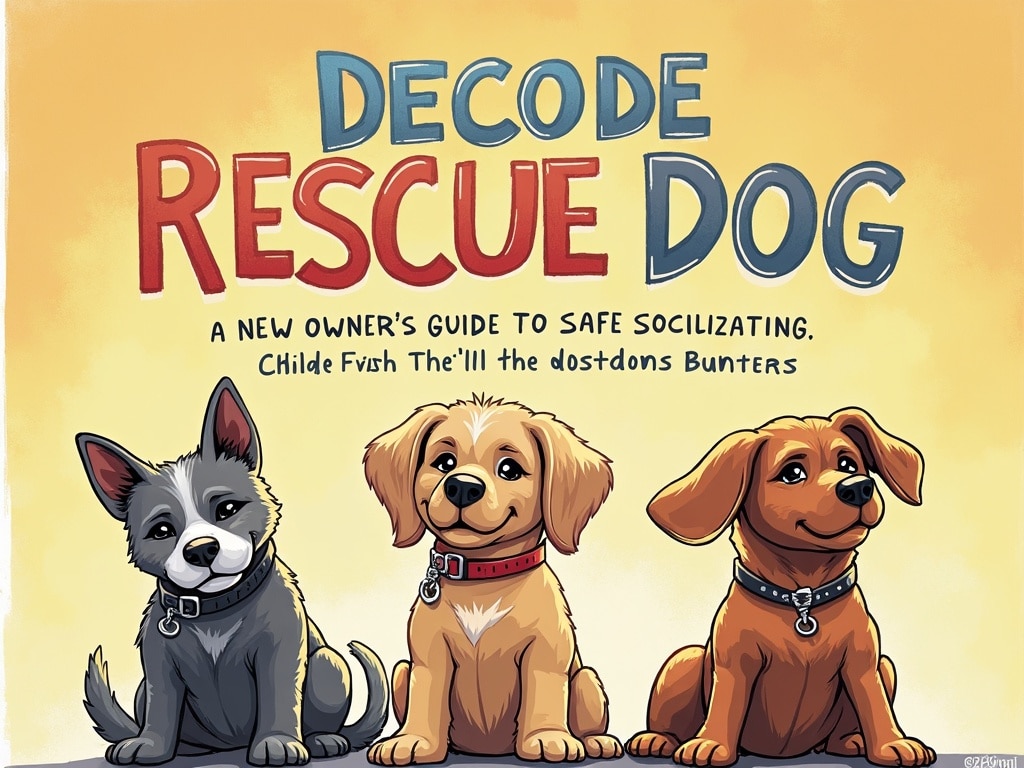Decode Your Rescue Dog: A New Owner’s Guide to Safe Socialization
Bringing a rescue dog into your home is a rewarding experience filled with love and companionship. However, it’s a journey that requires patience, understanding, and a commitment to safe socialization. Unlike puppies raised in stable environments, rescue dogs often come with unique challenges stemming from unknown or traumatic pasts. This guide provides new rescue dog parents with essential safe dog socialization techniques to help their furry friends thrive.
Understanding Rescue Dog Behavioral Challenges
Many rescue dogs have experienced neglect, abandonment, or even abuse. These experiences can lead to a range of behavioral issues, including anxiety, fear, aggression, and insecurity. It’s important to remember that these behaviors aren’t personal; they’re survival mechanisms developed in response to past trauma.
- Past Trauma’s Impact: A dog who was previously confined may exhibit separation anxiety. A dog who was mishandled could be fearful of touch.
- Common Behavioral Problems: These may include excessive barking, chewing, resource guarding (protecting food or toys), leash reactivity (reacting aggressively to other dogs on walks), and fear of strangers.
- Patience is Key: Understanding that these behaviors take time and patience to address is crucial. Progress may be slow, but consistency and positive reinforcement will make a world of difference.
Pre-Socialization Preparation: Creating a Safe Home Environment
Before introducing your rescue dog to the wider world, it’s essential to create a secure and comfortable home environment. This sanctuary will be the foundation upon which you build trust and confidence.
- Dog-Proofing Your Home: Remove any potential hazards such as toxic cleaners, medications, electrical cords, and small objects that could be ingested. This creates a safe and worry-free space for your new companion.
- The Importance of a Safe Space/Den: Provide your dog with a designated safe space, such as a crate or quiet corner with a comfortable bed. This should be a place where they can retreat when feeling overwhelmed or anxious. Never use this space as punishment.
- Establishing a Routine and Consistent Rules: Dogs thrive on routine. Set consistent mealtimes, walks, and bedtime. Establishing clear and consistent rules will help your dog understand expectations and feel more secure.
Building Trust and Bonding: Earning Your Dog’s Confidence
Trust is the cornerstone of any successful relationship, especially with a rescue dog. Building this trust takes time, patience, and consistent positive interactions.
- Reading Canine Body Language: Learn to recognize signs of stress, fear, or discomfort in your dog. These signs may include whale eye (showing the whites of their eyes), lip licking, yawning, panting when not hot, a tucked tail, or a stiff body posture.
- Effective Positive Reinforcement Methods: Reward desired behaviors with treats, praise, or toys. Avoid punishment-based training, as it can damage trust and increase anxiety.
- Establishing Yourself as a Leader: Leadership isn’t about dominance; it’s about providing clear guidance and security. Be consistent with your commands, provide structure in your dog’s life, and always act in their best interest.
Gradual Exposure: Introducing New Environments and Stimuli
Socialization isn’t about throwing your dog into the deep end; it’s about carefully and gradually exposing them to new experiences at their own pace.
- Desensitization and Counterconditioning: Desensitization involves exposing your dog to a stimulus at a low intensity until they no longer react. Counterconditioning pairs the stimulus with something positive, like a treat, to change their emotional response.
- Slowly Introducing New Sights, Sounds, and Smells: Start with quiet environments and gradually introduce more stimulating ones. For example, begin with a walk in your quiet neighborhood before venturing into a busy park.
- Appropriate Initial Exposure Times: Keep initial exposure times short and positive. End the session before your dog becomes stressed or overwhelmed. Observe their body language closely and adjust accordingly.
Safe Interactions: Introducing Other Dogs and People
Meeting new dogs and people can be stressful for a rescue dog. Carefully managed introductions are crucial to ensuring positive experiences.
- Identifying Compatible Playmates: Look for dogs with similar energy levels and play styles. Avoid introducing your dog to overly boisterous or pushy dogs.
- Rules for On-Leash Greetings: Keep initial on-leash greetings brief and controlled. Allow the dogs to sniff each other for a few seconds, then separate them. Watch for any signs of tension or aggression.
- Managing Interactions with Children: Always supervise interactions between your dog and children. Teach children how to approach and interact with dogs respectfully. Never leave a child unattended with a dog.

Recognizing and Responding to Stress Signals
Being able to identify and respond to your dog’s stress signals is essential for preventing negative experiences and building trust.
- Identifying Signs of Anxiety or Fear in Dogs: Common signs include panting, pacing, trembling, lip licking, yawning, tucked tail, flattened ears, whale eye, and a stiff body posture.
- Immediate Actions to Take When Your Dog is Stressed: Immediately remove your dog from the situation. Provide them with a safe space and offer reassurance.
- When to Remove Your Dog from a Situation: If your dog is showing signs of overwhelming stress, it’s crucial to remove them from the situation immediately. Pushing them beyond their comfort zone can damage trust and create negative associations.
Positive Reinforcement Training: The Key to Socialization Success
Positive reinforcement training is a powerful tool for building confidence and teaching your dog appropriate social behaviors.
- Basic Obedience Commands for Socialization: Teach your dog basic commands like sit, stay, come, and leave it. These commands can help you manage your dog’s behavior in social situations.
- Using Treats and Praise Effectively: Use high-value treats and enthusiastic praise to reward desired behaviors. Make training sessions fun and engaging for your dog.
- Benefits of Clicker Training: Clicker training can be a highly effective way to communicate with your dog and mark desired behaviors with precision. The clicker sound becomes associated with positive reinforcement.
Avoiding Common Socialization Mistakes
Even with the best intentions, it’s easy to make mistakes during the socialization process. Being aware of these common pitfalls can help you avoid them.
- Overwhelming Your Dog Too Quickly: Avoid overwhelming your dog by introducing too many new experiences at once. Gradual exposure is key.
- Forcing Interactions: Never force your dog to interact with other dogs or people if they are showing signs of stress or fear. Allow them to approach at their own pace.
- Ignoring Stress Signals: Pay close attention to your dog’s body language and remove them from the situation if they are showing signs of stress.
Seeking Professional Help: When to Consult a Veterinarian, Trainer, or Behaviorist
Sometimes, despite your best efforts, your rescue dog may require professional guidance.
- Signs Your Dog Needs Professional Intervention: These include aggression, severe anxiety, destructive behavior, and fearfulness that interferes with daily life.
- Benefits of Professional Guidance: A qualified professional can provide a tailored training plan, identify underlying behavioral issues, and offer support and guidance.
- Finding a Qualified Professional: Look for a veterinarian, certified dog trainer, or veterinary behaviorist with experience working with rescue dogs. Check their credentials and read reviews.
Long-Term Socialization and Enrichment
Socialization is an ongoing process, not a one-time event. Continue to provide your dog with opportunities to socialize and engage in enriching activities throughout their life.
- Maintaining a Well-Socialized Dog: Regularly expose your dog to new people, places, and experiences to maintain their social skills.
- Providing Enrichment Activities: Puzzle toys, chew toys, and interactive games can help keep your dog mentally stimulated and prevent boredom.
- Benefits of Ongoing Training: Continue to reinforce basic obedience commands and introduce new challenges to keep your dog engaged and mentally stimulated.
Decoding your rescue dog and providing them with safe dog socialization techniques is an investment that will pay off in countless ways. With patience, understanding, and a commitment to positive reinforcement, you can help your rescue dog overcome their past and blossom into a confident, well-adjusted companion. Remember, every dog is an individual, and progress may vary. Celebrate the small victories, and never give up on your furry friend.

